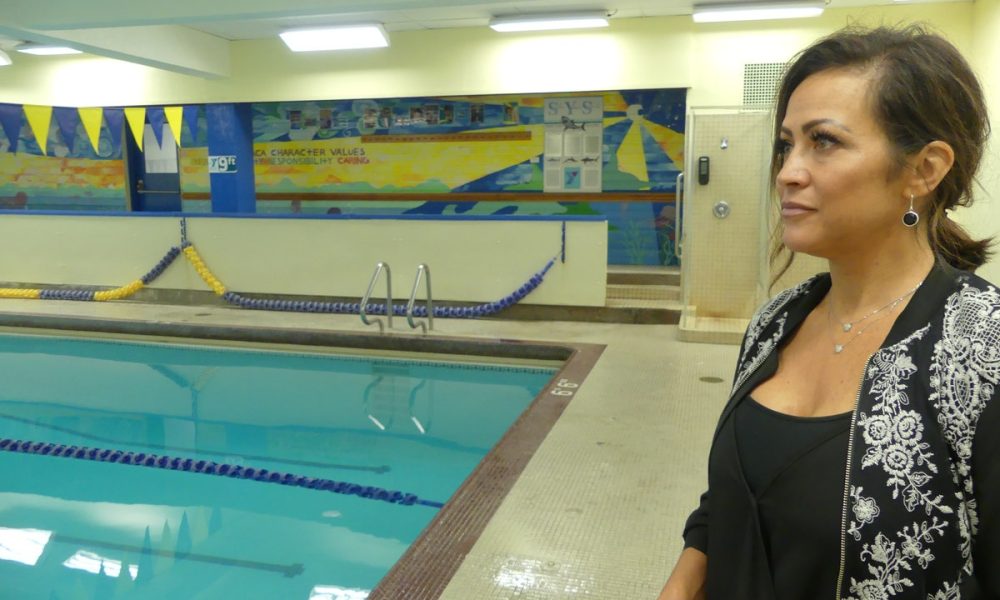
Development director Laura Morett speaks about the YMCA’s aging Salem headquarters in front of the non-regulation size basement pool. (Rachel Alexander/Salem Reporter)
Salem’s YMCA is moving ahead with an ambitious plan to replace its aging building – and asking the community to chip in $14.5 million.
It’s a large project for an organization that was losing money until several years ago and which is currently operating with almost no financial reserves, according to publicly available tax documents.
Sam Carroll, chief executive officer, has worked to turn that around since December 2014.
“We were definitely close to shutting our doors,” he said.
The nonprofit is caught in a chicken-and-egg situation. The nearly century-old building on Court Street, just across from the state capitol, costs about $700,000 to operate annually, Carroll said, including three full-time staff members whose only job is to fix things.
After staff compensation, it’s by far the biggest expense for the Y, which spent $4.3 million total in 2017, according to tax documents.

Kareena Slakey, an attendant at the Y’s childcare facility, helps a young member eat a juice snack. (Rachel Alexander/Salem Reporter)
A new center would halve those costs by reducing the need for repairs and lowering energy costs through a modern heating system.
“That changes the financial picture,” Carroll said.
It would also allow the Y to gain new members who want to work out at a gym with nicer, newer equipment.
But with about $260,000 in cash reserves, the organization isn’t in a position to build.
“It’s been on survival mode for a while,” said Chuck Adams, the YMCA board president, who has served on the board for 12 years.
A big breakthrough came in 2017, when the Legislature allocated $12 million in lottery bonds for the building.
Now, the nonprofit is kicking off a campaign to bring that total to the $26.5 million it needs.
It also means changing the way the YMCA talks about itself.
“We are more than just a gym,” said Laura Morett, the Y’s newly hired development director.
Even among gyms, the YMCA is unusual: It offers sliding scale membership fees that are flexible. If your income says you should be paying $50 a month and you can’t afford it, the staff will figure a reduced amount. That’s part of the organization’s Christian values, which include not judging people and offering services to all, Carroll said.
“Do I know if you’ve got school loans? Do I know if you’ve got medical bills? Do I know if you’re taking care of a parent?” Carroll said.

Y members work out in the downtown building’s main gym, first constructed in 1926. (Rachel Alexander/Salem Reporter)
The Y also provides free warm-water pool therapy for kids who use wheelchairs, free childcare for members, youth sports leagues and programs for cancer survivors.
Currently, it has about 2,500 memberships covering 8,000 individuals. More than half receive some sort of financial assistance.
State Sen. Peter Courtney has been a Y supporter since 1969, when he took a room in the building after hopping off a Greyhound bus in Salem to take a law clerk job. The former Rhode Islander lived there for several years as he got acquainted with Oregon, and still regularly runs and plays pick-up basketball there.
“The Y and I are inseparable,” he said.
He worked to secure the lottery bonds for the building project, and said he believes the fundraising goal is doable — but difficult.
“It’s hard raising money, especially now,” he said. “Salem, to our credit, has many very, very worthwhile projects.”
Recent nonprofit capital campaigns in Salem have been smaller, and often spread over longer timeframes. The Salem-Keizer Education Foundation recently wrapped up a two-and-a-half year campaign to raise $3 million for a new headquarters, retiring executive director Krina Lee said.
The Career and Technical Education Center, a public-private partnership between Salem-Keizer schools and Mountain West Investment Corp., will have raised close to $17 million over five years when its final two programs open next fall, said Chuck Lee, who runs the Mountain West side of the project.
And the Ray and Joan Kroc Corps Community Center of the Mid-Willamette Valley, which was built in 2008, set a goal of $8 million in local funds, ultimately receiving $10 million. The Y board had planned to begin a capital campaign that year to replace its old building, but was asked by community leaders to step back in order to not compete with the other project, Carroll said.

YMCA development director Laura Morell said the labyrinth-like layout of the current building leads to wasted space and higher costs. (Rachel Alexander/Salem Reporter)
To receive the bonds, the Y must have tangible plans for construction in place by next spring, Courtney said. That doesn’t mean the organization has to break ground, but it does have to show the project is actually going to happen, which would include having all the money available.
Adams said staff and board members are focusing on corporate donors and foundations this fall. That push includes naming rights: $50,000 for the elevator, $1 million for the gym, or $6 million for the whole building.
Construction on the new center is scheduled to begin in the spring of 2019 and finish in fall 2020. The new building will be a three-story fitness and community center, including a regulation-sized pool, saunas, a track and studio space for classes.
The managers also would be rid of the buckets set up to catch water leaking from pipes in the basement child care area.
It’s a fast timeline to raise $14.5 million, but Adams said he’s not worried. The bulk of large donors should be in place by the end of the year, he said, and donors have pledged about $1 million to date.
The YMCA will also look at some tax credits and other incentives that could lower the amount needed.
“Failure is not going to be an option,” he said.









